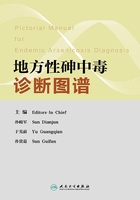
Preface
Endemic arsenicosis is a chronic poisoning disease found in the residents living in some specific geographical regions. These residents drink groundwater which is excessively rich in inorganic arsenic, eat high inorganic arsenic contaminated dried foods and breathe arsenic polluted air in their households owing to burning high arsenic coal in the open stoves over a long period of time. As such, the residents would manifest the specific hyper-pigmentation or/and hypopigmentation on unexposed body skin, mainly on their trunk and hyperkertosis on their palms and soles. Inorganic arsenic, the etiological factor, is a human carcinogen confirmed by International Cancer Research Center. This chemical can cause skin cancer, liver cancer, lung cancer and so on. Up to now, it is known that the prevalence of endemic arsenicosis has taken place in more than 20 countries around the world. China is one of the countries, where endemic arsenicosis is more serious. The affected areas are very wide and many residents there in these areas have been endangered. There are two types of endemic arsenicosis in China. One is drinking water type of arsenicosis caused by drinking arsenic contaminated groundwater, and the other is coal-burning type of arsenicosis, which is found only in China, and is caused by the burning of arsenic-rich coal in open stoves in the households. The national statistics report of endemic disease in 2010 showed that drinking water type of endemic arsenicosis was distributed in 16 provinces (autonomous regions),656 villages, classified as ‘arsenicosis villages’, where arsenicosis patients were diagnosed, while in 1642 villages, where residents consumed high levels of arsenic in groundwater as their drinking water but no patient was found. These villages are classified as ‘potential arsenicosis villages’.Around the country, the total population threatened by consuming high arsenic in groundwater as drinking water is about 1.95 million, and the number of diagnosed arsenicosis patients is about 20, 000. The areas of Coal-burning type endemic arsenicosis are located in Guizhou and Shaanxi provinces, the threatened population are near 1.22 million in about 370, 000 households in 1657 villages, and about 16, 000 people were diagnosed as arsenicosis patients.
Since 1992, endemic arsenicosis has been classified as the national key endemic disease in China. After 20 years of endeavours for the prevention and control of the disease, remarkable results have been achieved. At present, 567 endemic arsenicosis villages and 1578 potential arsenicosis villages have been provided with arsenic-safe/improved drinking water supply. The statistic survey on endemic arsenicosis areas in 2010 showed that the provision rate of arsenicsafe/improved water supply in endemic arsenicosis villages and potential arsenicosis villages was 85.01% and 80.14% respectively. For the prevention and control of coal-burning type arsenicosis, all 374, 300 households in 1367 affected villages have been provided with improved stoves. However, consistent hard work is required for proper operation and maintenance of the arsenic-safe/improved water supply systems already provided in the affected villages. And proper maintenance of the improved stoves provided in the affected households should be vigorously ensured to eradicate endemic arsenicosis in a sustainable manner.
During the “Twelfth Five-Year Plan” period (2010 to 2015), the mitigation of endemic arsenicosis was still enlisted in the action plan for Endemic Disease Control and Prevention with specific objectives. These are: First, projects to construct arsenic-safe/improved water supply in the identified endemic arsenicosis areas; Second, projects that resulted in the provision of more than ninety percent arsenic-safe/improved water should maintain their proper operation and the water quality should meet the Chinese national drinking water standards. The arsenic-safe/improved water supply project, after its installation, should be properly maintained and timely repaired; and Third, in the coal-burning type areas, action should be taken to ensure proper operation and maintenance of the improved stoves in more than 90% affected households after their installation.
Correct diagnosis of endemic arsenicosis is the basis for successful accessing and evaluation of the effectiveness in the prevention and control actions. To fully achieve the national objectives,with the active support of the Bureau of Disease Control and Prevention, the Ministry of Health and the firm assistance from the UNICEF, the Endemic Disease Control Center of Chinese Center for Disease Control and Prevention (referred to National Center) has coordinated the experts with long and relevant experience from the Harbin Medical University, the Chinese Medical University,the Guiyang Medical College, the Inner Mongolia Center for Endemic Disease Control, the Shanxi Institute for Endemic Disease Control, the Guizhou Center for Disease Control and Prevention, and the 44th Hospital of the People’s Liberation Army to compile valuable clinical and pathological photos of arsenicosis patients, and to describe how to diagnose endemic arsenicosis in accordance with the Chinese national criteria . Their contribution has resulted in this pictorial manual.
This manual is pided into four sections covering drinking water type and coal-burning types arsenic poisoning and their prevalence and prevention; clinical diagnosis of arsenicosis;skin pathological changes of endemic arsenicosis; and endemic arsenic poisoning identification and diagnosis. The manual is prepared for the use of personnel working in the field for prevention and research work and also as teaching material.
Owing to certain restriction in overall recognition and limited capacities on the part of the authors, some shortcomings are surely inevitable. Criticism and advices, therefore, are more than welcome.
National Center for Disease Control and Prevention, Chinese CDC
Harbin Medical University
June, 2015